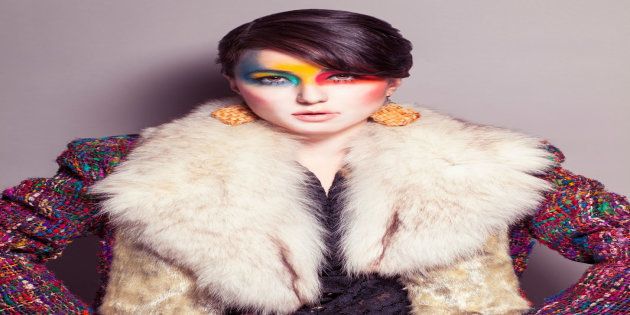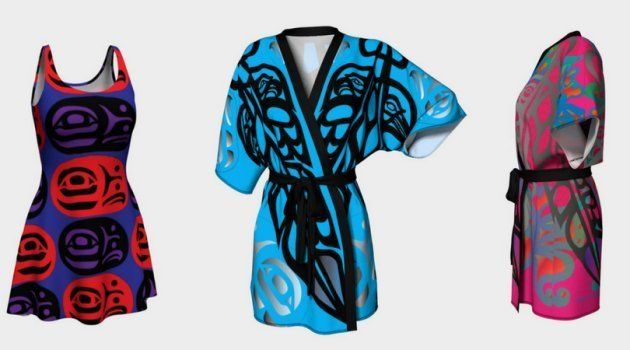
The examples are endless. There was Free People's $111 "medicine pouch," Karlie Kloss in a feathered headdress on the Victoria Secret runway, and Dsquared2's attempt to market its fashion line with a racial slur.
Fashion companies present a cheap, sexualized version of Indigenous design, rarely delving into the rich traditions and cultures from which it comes.
"Basically, the fashion industry sucks," says Joleen Mitton, a former model and producer of the inaugural Vancouver Indigenous Fashion Week. "It's fun, it's artistic ... but at the end of the day, there's no spiritual aspect to that kind of industry."
As a teenager, Mitton travelled around the world to model. But it wasn't her experience in the fashion world that inspired Vancouver Indigenous Fashion Week — it was the kids she met when she came home.
Mitton, who has Plains Cree, Blackfoot heritage, has worked with First Nations kids living in foster care for nine years, she tells HuffPost Canada in an interview. She noticed they didn't have many Indigenous role models, and started holding mini fashion shows and beauty nights for the girls.
Basically, the fashion industry sucks.Joleen Mitton
"Fashion was something that really grabbed them," Mitton's co-producer Christine Spinder says in an interview. "They're teens, right? They're looking for identity. And fashion does that — it's both personal and universal."
Four days of fashion shows — running from July 26 to 29 at the Queen Elizabeth Theatre — feature many models who are Indigenous teens living in foster care. They'll be wearing designs by Indigenous artists from across the continent.
"When you're in foster care, you don't get the nourishment of your own culture," Mitton said in a video for True Calling Canada. "I do fashion shows and use Indigenous fashion design to get them connected because culture saves lives in a big way."
These teenagers are the "heart of the project," Spinder says. "The fashion part of it and the show part of it is super fun ... but if we had to bring it down to one reason why we're doing it, it's these kids."
Regalia is considered one of the highest art forms in many Indigenous cultures, Spinder notes. So the clothing can teach both Indigenous people and non-Indigenous Canadians about traditional cultures.
Special regalia is often worn during ceremony and celebrations like powwows, so it has strong spiritual significance. As for the clothes that will be shown at VIFW, Mitton said the meaning comes from how they're made.
If you know where your fabrics are coming from, just like how if you know where your food is coming from, there's more integrity.Joleen Mitton
"It's a different take on the fashion world," Mitton says. "A lot of the Indigenous fashion is handmade, it's a lot slower, there's more intention involved. If you know where your fabrics are coming from, just like how if you know where your food is coming from, there's more integrity."
Clothing made in Indigenous traditions is the opposite of the mass-produced, fast-fashion that's popular today. But it's still modern.
"Being able to bring all this design together in a modern context is going to really highlight to non-Indigenous Canadians that the Indigenous world is not only live and visible today, but it is hugely diverse and very contemporary," Spinder says.

The fashion industry has always shown a taste for Indigenous culture, but that hasn't been expressed very tastefully, Spinder says.
"Design houses and manufacturing houses across the world mimic and copy Indigenous design ... What we're saying is 'Buy direct from the creators. Buy from the people who make it and then it will actually have some meaning.'"
"A lot of people don't even realize that the garments that they're buying, that are emblazoned with totem poles and symbols and faces and patterns, have been directly ripped off from even specific sites here in Vancouver," Spinder says.
Buy direct from the creators. Buy from the people who make it and then it will actually have some meaning.
"One time I saw a fellow walking down the Stanley Park seawall wearing an Adidas jacket that had a full technicolour imprint of the totem poles that stand in Stanley Park. And he obviously had no idea that this was a place of some significance.
"So what we want to do is highlight the fact that there are incredible Indigenous designers to buy directly from, and when you buy from them, what you're getting is not only an incredibly well-made garment, but actually is connected to the source culture that created it," she explains. Their aim is to "match social change with art."

Celebrating Indigenous design should be a no-brainer. "We're the first peoples that were here," Mitton said. "I think it just makes sense, doesn't it?"
